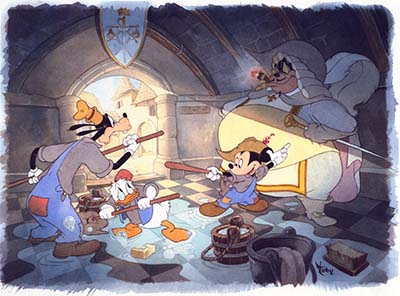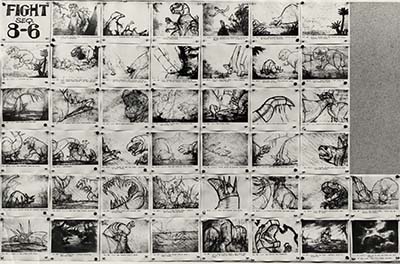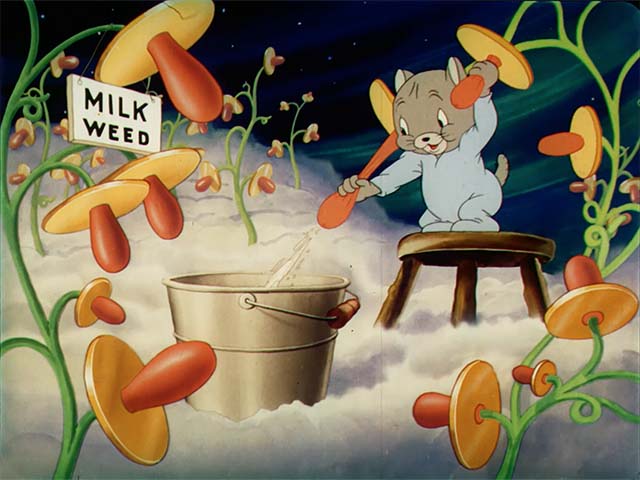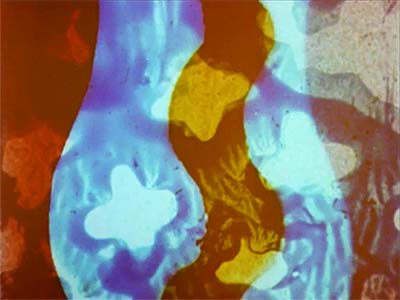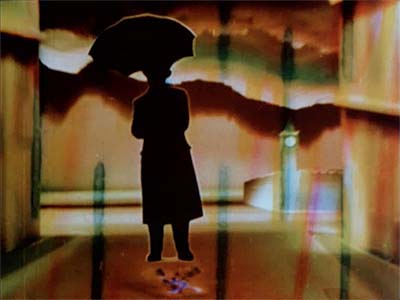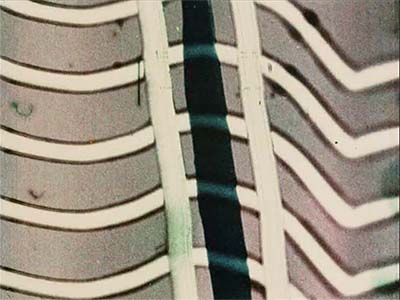LAST CALL! The Bonus Archive will be updated soon and these downloads will be removed from the server. If you haven’t grabbed them yet, now is the time before it’s too late!

As a special thank you to our annual General and Student members, we have created a special page where we will archive past Reference Packs. There will be a new rerun of a complete RefPack between the new ones.
Available to Student and General Members
Toby Bluth Storyboard Collection![]()
Fantasia / Pinocchio (1940)
From his childhood years in Texas on through to his family’s move out to Los Angeles, Toby Bluth was enamored with the animated films of Walt Disney. Their story sense and striking visuals would inspire him to a long career in creating beautiful imagery. He went on to design and direct over one hundred stage productions; he illustrated numerous children’s books; and he worked on countless projects in animation. Some highlights include winning the Hollywood Drama-Logue Critics Award four times, and being named Disney Fine Art’s top selling artist for a number of years. He also was art director for the Disney animated films The Tigger Movie and Mickey, Donald, Goofy: The Three Musketeers.
In his later years he would refer to the first five Disney animated features as his greatest inspirations. His intense love led to a close study of these films, and their influence can be seen in just about everything he created in his life. Even his home, with its wooden corbels and stained glass windows, were reminiscent of something out of Pinocchio.
While working as the art director on The Tigger Movie he had copies made of nearly every layout drawing from Snow White that was in the Disney Animation Research Library. Now I don’t know how crucial those were as reference for the look of this particular Winnie the Pooh feature, but Toby didn’t miss his chance to be able to study these rare treasures. He certainly had an eye for the good stuff!
This collection of storyboards is a vivid example of the sort of reference material that inspired and influenced Toby’s art. They were his most prized posessions. The clarity of staging and lighting in the early Disney features is something Toby always strived for in his own work. When explaining the appeal of his drawings and watercolor paintings he would refer to the importance of light and air. He would often refer to chiaroscuro, the treatment of light and dark, and its importance to his technique.
In Toby’s paintings, the highlights and shadows defined both mood and form. When he began a painting, he would always paint the atmosphere first. He would achieve this by laying in a wash to represent the shadows in a complimentary color to the source light. Next, he would glaze in the local color in layers, one after another. His pencil drawings would be also be completely rendered to show form and depth, a standard practice for the early Disney films, but not always done in later animated productions. You can see this wonderful examples of these rendered layout drawings in some of the storyboards contained in this collection.
I’m sure Toby would be happy to know his collection can now be shared with other students of fine image making, and likely for the very first time. I hope they inspire you as much as they did him! –Colby Bluth
Many thanks to the family of Toby Bluth for sharing this important collection with us. This e-book is set up to be printed single sided on 11 x 17 inch paper, so you can print it out and pin it up on cork boards.
Click to access the…
Downloads expire after October 2024
Milky Way
MGM / Rudolph Ising / 1940
Perhaps the most unjustly neglected classic animated shorts are the early MGM cartoons. Hugh Harman and Rudy Ising left Warner Bros in 1934 to join MGM, producing several cartoons starring Bosko, along with a series of musical one-shot cartoons called Happy Harmonies. Roughly patterned after Disney’s Silly Symphonies, these musical cartoons ran far over budget, and in 1937, MGM severed its contract with Harman and Ising and formed their own in-house animation studio under Fred Quimby. Harman and Ising were hired on as contract employees of MGM, directing one-shots and Barney Bear cartoons until they parted company with the studio during WWII.
The two films we are sharing with you today represent the best of Harman and Ising’s work. “Milky Way” was the first non-Disney animated short to be awarded an Oscar, winning over the first Bugs Bunny cartoon and the first of the Tom & Jerry shorts. It richly deserved the honor. The lushness of the production values rivals the most elaborate of Disney’s shorts. In particular note the solidity of the drawing by Mike Lah, Pete Burness and Ray Abrams, the brilliant color palettes of the backgrounds, and the spectacular effects animation. Many of the shots in this short consist of pans with action beginning in one end of the pan and tracking it through to the other end. This contributes to the forward momentum of the film and prevents it from dragging like so many other Harman-Ising cartoons.
Click to access the…
Downloads expire after October 2024
The Hungry Wolf
MGM / Hugh Harman / 1942
The other MGM film we are featuring, “The Hungry Wolf” is unique to the Harman-Ising filmography. Produced at the very end of the directing partners’ tenure at MGM, the animation staff includes many of the finest artists ever to work at the studio… in particular, Irv Spence, Ken Muse, Jack Zander and Pete Burness. When this film was made, Rudy Ising had already left MGM to open his own studio. Soon after, Rudy Ising would resign to join the Army Air Force’s First Motion Picture Unit.
A while back, I received a phone call from Ralph Bakshi asking me about this film. He had stumbled across it on YouTube and was blown away. He praised the power and guts of the animation- clarity and directness of purpose quite different than the typical “lily gilding” and excessive polish common in Harman-Ising cartoons. Ralph pointed at a few scenes in particular and asked who the animator was. It turned out to be Bill Tytla, who was picking up work with MGM after the Disney strike. Ralph insisted I share this film with all of you so you can study it too. Here it is!
Click to access the…
Downloads expire after October 2024
Many thanks to Advisory Board member Steve Stanchfield for sharing these rare films with Animation Resources. We are very fortunate that Steve uncovers these lost jewels and shares them with us. Steve’s video company, Thunderbean Animation is doing great work transferring and restoring rare animated films. We greatly appreciate his unfailing support of our Animation Archive Project.
Five Films By Len Lye![]()
Tusalava (1929) / Kaleidoscoper (1935) / Rainbow Dance (1936) / Doing The Lambeth Walk (1939) / Musical Poster No. 1 (1940)
Len Lye was a revolutionary figure, not only in the history of animation, but of fine art as well. His work explored motion through experimental film and kinetic sculpture. It is well worth taking a few moments to read the Len Lye Wikipedia Page if you aren’t familiar with him. But there are some personal points I need to make about these films to get across their context to you.
Whenever we post experimental films on Animation Resources, inevitably I am asked how any of this relates to what character animators do. Artists will say that abstract animation is interesting, but they don’t see how it applies to their own work. Nothing can be further from the truth. Animation is more than just creating characters and telling stories. Comics and illustration have characters and stories, but the thing that makes animation unique is the element of time. Len Lye strips away all of the narrative and figurative elements and focuses entirely on rhythm and the visual representation of music. Few other animated films are as concentrated when it comes to this kind of unity of sound and image. Lye was essentially distilling animation down to the one thing that makes the medium totally unique.
The technique is drop dead simple and direct… Lye painted directly on blank rolls of film with colored dyes and created layers of movement in an optical printer. But that is just the surface. It goes much deeper than that. The planning required to achieve this complete synthesis of sound and motion required incredible concentration. Think about it a moment… Lye was breaking down the soundtrack into its individual voices and rhythms and representing all that on exposure sheets frame by frame. How did he do that? What did Lye’s notes and plans look like before he began work? I really don’t know, but the level of detail and the abstract thinking involved is staggering.
Too often, animators slug their exposure sheets according to the length of the dialogue and how long it takes to perform an action, with no thought given to pacing or rhythm. Len Lye is operating on a much more sophisticated level. He represents complex syncopated Latin and jazz rhythms visually with abstract shapes that move. The technique of painting little doodles of shapes on film gives it a deceptively simple appearance, but the planning going on under the hood must have required fourth dimensional thinking. Imagine if instead of the action in an animated film happening at a normal pace dictated by the speed the voice actor performs the dialogue, the animator creates a rhythmic pattern for the action that merges the character’s performance with the beats and accents in the music… Are you beginning to understand the importance of these films now?
In the past, animation was planned out to a musical beat. The music established the pace of the footsteps and the rhythm of the action. The way this was achieved was by analyzing the voices in the music and breaking down the rhythms frame by frame. When Len Lye’s and Norman McLaren’s films first were shown, traditional animators sat up and took notice. They were greatly impressed by how these seemingly simple little films effortlessly accomplished amazingly complex things that the Hollywood animators struggled to do in their character animation. When I was first becoming interested in animation in the early 1980s, there was a Len Lye retrospective where many of his films were screened for the first time. I attended the screening and was amazed to look around the audience… it was a virtual who’s who of animators from Disney, Warner Bros, MGM and every other major animation studio. These great animators thought there was something to learn from these films. You should too.
Click to access the…
Downloads expire after October 2024
If you are currently on a quarterly membership plan, consider upgrading to an annual membership to get access to our bonus page with even more downloads. If you still have time on you quarterly membership when you upgrade to an annual membership, email us at…
membership@animationresources.org
…and we will credit your membership with the additional time. These bonus downloads expire after November 1st, 2024.
THIS IS JUST THE TIP OF THE ICEBERG!
Animation Resources has been sharing treasures from the Animation Archive with its members for over a decade. Every other month, our members get access to a downloadable Reference Pack, full of information, inspiration and animation. The RefPacks consist of e-books jam packed with high resolution scans of great art, still framable animated films from around the world, documentaries, podcasts, seminars and MORE! The best part is that all of this material has been selected and curated by our Board of professionals to aid you in your self study. Our goal is to help you be a greater artist. Why wouldn’t you want to be a member of a group like that?
Membership comes in three levels. General Members get access to a bi-monthly Reference Pack as well as a Bonus RefPack from past offerings in the in-between months. We offer a discounted Student Membership for full time students and educators. And if you want to try out being a member, there is a Quarterly Membership that runs for three months.
JOIN TODAY!
https://animationresources.org/membership/levels/
FREE SAMPLES!
Not Convinced Yet? Check out this SAMPLE REFERENCE PACK! It will give you a taste of what Animation Resources members get to download every other month! That’s 560 pages of great high resolution images and nearly an hour of rare animation available to everyone to download for FREE! https://animationresources.org/join-us-sample-reference-pack/
![]()
![]() Animation Resources depends on your contributions to support its projects. Even if you can’t afford to join our group right now, please click the button below to donate whatever you can afford using PayPal.
Animation Resources depends on your contributions to support its projects. Even if you can’t afford to join our group right now, please click the button below to donate whatever you can afford using PayPal.
















